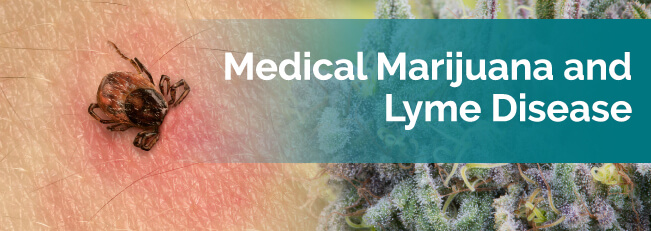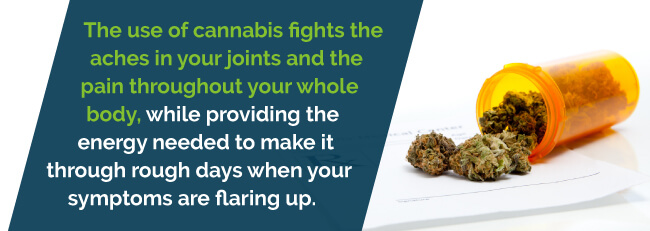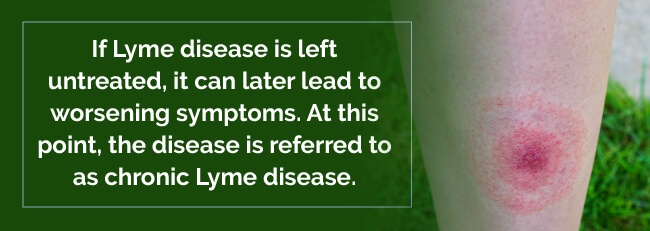
Every year, more people in the U.S. are diagnosed with Lyme disease than HIV and breast cancer combined. This insidious disease quietly attacks a patient’s bodily systems, and many are unaware what is happening. Because of the common symptoms associated with the condition, misdiagnosis is common.
It’s important to receive early treatment for Lyme disease, as the illness can lead to serious side effects and related complications. Though not a typical treatment for Lyme, medical marijuana may be just what the doctor ordered. Read on to find out how this natural medication could be used to treat your Lyme disease symptoms or the disease itself.
Many individuals who suffer from Lyme disease do not think about cannabis as an effective long-term medicine to help alleviate symptoms of this condition. But marijuana has antibacterial properties which could be crucial to treating the disease.
Medical marijuana helps Lyme disease sufferers manage their symptoms. Cannabis is a far safer and smoother medication that can eliminate pain from this condition in all forms. The use of this drug fights the aches in your joints and the pain throughout your whole body, while providing the energy needed to make it through rough days when your symptoms are flaring up.
Find A Doctor Find A Dispensary

More and more studies show that cannabis has antibiotic properties, even treating diseases standard antibiotic medications can’t. It has even proven to be an effective treatment for the flesh-eating virus known as MRSA. Studies also show the spirochetes that cause Lyme disease can be treated using cannabidiol (CBD).
Because of the federal laws banning marijuana, much of this evidence is anecdotal. As our bodies become more resistant to certain types of antibiotics, more studies should be dedicated to discovering marijuana’s potential in this field.
Lyme disease can cause pain in multiple areas of the body. This includes headaches, body aches, muscle aches and joint pain. Medical marijuana is effective as a chronic pain treatment.
Cannabis is much more effective than aspirin as an anti-inflammatory. It serves as both a muscle relaxer and joint pain reliever. When the immune system kicks into overdrive, inflammation usually results. Both CBD and THC work with our body’s endocannabinoid system to modulate that response.
A frequent use of cannabis is as an anti-nausea medication. Medical marijuana can limit and even prevent bouts of nausea or vomiting caused by many different conditions. It can also induce hunger, allowing patients to eat and regain their strength.
If you struggle with fatigue caused by Lyme disease, there could be two reasons. The disease is known to zap a patient’s energy, creating a feeling of lethargy. It can also prevent patients from getting a good night’s rest. Medical marijuana can treat both of these causes. Sativa strains are known to increase energy, while Indica strains induce sleep.
Cannabis use directly affects the cannabinoid receptors that affect mood. Many people who struggle with depression find relief in the uplifting properties of marijuana.
One of the less common side effects of Lyme disease is seizures. However, these can become quite severe in some patients. Medical marijuana is a proven treatment for seizures. Patients have seen a dramatic improvement in the number of episodes they experience, and sometimes the seizures are eradicated by cannabis use.
Not all strains are the same, so patients should be aware of a product’s chemical profile and effects before selecting a cannabis medication. Also, depending on the symptoms being experienced moment to moment, patients may need to use different strains at different times.

Cannabis medications that have both THC and CBD were shown to be most effective for Lyme disease patients. Many prefer products high in CBD, which provide the benefits of marijuana without the high. However, CBD has been known to produce short-term memory issues and brain fog. This may worsen the cognitive problems associated with Lyme disease.
Although patients should always speak to their doctors or a budtender at a local dispensary for strain recommendations, here are some popular strains and the symptoms they treat.
Cannabidiol cream can be directly applied to rash outbreaks. Topicals can also help relieve joint pain when used during flare-ups. This form of medication seeps directly into the skin above the affected area.
The transdermal patch is also applied directly to the skin. Much like a nicotine patch, it allows medications to be released over an extended period of time, bringing long-term relief.
Ingesting infused marijuana edibles or cannabis oil has proven to be an effective mode of treating Lyme disease. When you eat cannabis-infused food or place the products below your tongue, it allows the cannabinoids to target the bacteria which cause Lyme more directly.
Cannabis juice may also be available in your area. If so, this product is highly recommended for Lyme patients, as it reduces the pain and inflammation associated with the disease — without the high.
Inhaling marijuana smoke is less effective at treating the bacteria which cause Lyme disease. However, if you are suffering from acute pain or nausea, this mode allows the cannabis medication to treat your symptoms more quickly. Many doctors prefer their patients not to smoke, however, as smoking can irreversibly damage your lungs.
Before pursuing cannabis treatments, you need to be registered with your state as a medical marijuana patient. No states have specifically listed Lyme disease as one of the qualifying conditions for their program. However, some of the chronic symptoms, like pain and nausea, are included.
The first step to becoming a medical marijuana patient is making an appointment with a marijuana doctor. They can confirm if your condition qualifies you for your state’s program. They can also suggest the best products and dosage to treat your symptoms.
Find A Doctor Find A Dispensary
Lyme disease is a vector-borne illness, which means it is caused by the bite of an infected arthropod — specifically, the deer tick (Ixodes scapularis). The emergence and spread of Lyme disease are relatively recent developments, but are becoming serious concerns.
The disease is bacterial. In the U.S., it is caused by the Borrelia burgdorferi or Borrelia mayonii bacteria of the spirochete family. It’s difficult for our immune system to detect Lyme, which makes it difficult to kill. Once contracted, the disease is not contagious between humans. However, pregnant women can pass it on to their unborn children.
The most dangerous aspect of Lyme disease is that patients can live for years without knowing they have the condition. At that point, antibiotic treatments are either slow or completely ineffective.
The bacteria Borrelia burgdorferi can form into a cyst when they feel threatened, such as when a patient is undergoing antibiotic treatments. When in cyst form, the disease presents no symptoms, which may lead patients to believe they are cured. Unfortunately, when these cysts return to their spirochete form, symptoms of the disease also return.
Some patients bounce back from Lyme disease with no apparent symptoms, while others struggle with debilitating complications for years. No one knows why. However, the answer may lie in the body’s endocannabinoid system.
The endocannabinoid system brings balance between the mind and the body. Cannabinoid receptors are found throughout the body, including our neurological system and immune system. When a patient has a condition like Lyme disease, the endocannabinoid system is thrown off balance, and multiple systems can be affected.
If a patient is unable to recover from Lyme disease, it could be that the condition negatively impacts the cannabinoid receptor (CB2) found in the immune system.
Diagnosing Lyme disease is very difficult. It’s called “the great imitator” because the symptoms resemble many other conditions. Misdiagnosis is common, and experts believe the number of Lyme patients may be higher than we know.
When the customary rash does not appear, your physician may try the following to determine if you have Lyme disease:
It’s common knowledge that Lyme Disease typically comes from ticks. But did you know that:
Diagnosing Lyme disease early is crucial to treatment. The sooner the disease is caught, the better antibacterial treatments will work. Early symptoms of Lyme disease include:

If Lyme disease is left untreated, it can later lead to worsening symptoms. At this point, the disease is referred to as chronic Lyme disease. Any form of a delayed or inadequate approach to treating this condition can lead to more severe conditions that may be life-threatening. This may involve issues like:
Although depression may seem like a mild side effect of the disease, it should be taken seriously. The leading cause of death in those with Lyme disease is suicide caused by depression.
When the symptoms of Lyme disease flare up, patients are left feeling weak and wracked by pain. This not only affects the patient, but their family and friends. The disease can leave them unable to go to work or live their daily lives.
Prevention is always the best treatment for any disease. If you live near a grassy or wooded area known to have ticks, use bug spray and wear long pants and sleeves. If you do get a tick, immediately remove it, but do so carefully. The longer the tick is attached, the greater the risk of transmitting the disease.
It’s important that patients go to a doctor if they suspect their tick bite was infected with Lyme disease. The CDC doesn’t recommend treatment if patients don’t present a rash. However, less than half of those with the disease develop a rash. This delay in treatment could cause the disorder to evolve into a more serious condition.
Conventional treatments for Lyme disease include the following:
In many cases, antibiotics can eliminate the infection and the symptoms associated with Lyme disease. If treated early, antibiotics are usually the most effective treatment for this condition. The most common oral antibiotic used to treat Lyme disease is doxycycline.

Overusing antibiotics can be dangerous. They may cause damage to your gastrointestinal system. They can also kill the healthy bacteria found in your body, increasing your chance of fungal and bacterial infections.
There are some who believe this treatment doesn’t actually work. Other have found great success if the condition is treated within the first few weeks.
To help with tense muscles and sore joints associated with the disease, doctors often prescribe NSAIDs (nonsteroidal anti-inflammatory drugs) or muscle relaxants. These types of medications are associated with a whole range of side effects, from stomach ulcers and digestive issues to blurred vision, headaches and dizziness.
If a patient’s pain worsens, doctors tend to prescribe prescription opioids like oxycodone or even morphine. These prescription drugs are well-known for their addictive nature. They also have a huge list of side effects which can affect the digestive system and other vital organs.
Many individuals who suffer from Lyme disease do not think about cannabis as an effective long-term medicine to help alleviate symptoms of this condition. But marijuana has antibacterial properties which could be crucial to treating the disease.
Medical marijuana helps Lyme disease sufferers manage their symptoms. Cannabis is a far safer and smoother medication that can eliminate pain from this condition in all forms. The use of this drug fights the aches in your joints and the pain throughout your whole body, while providing the energy needed to make it through rough days when your symptoms are flaring up.

More and more studies show that cannabis has antibiotic properties, even treating diseases standard antibiotic medications can’t. It has even proven to be an effective treatment for the flesh-eating virus known as MRSA. Studies also show the spirochetes that cause Lyme disease can be treated using cannabidiol (CBD).
Because of the federal laws banning marijuana, much of this evidence is anecdotal. As our bodies become more resistant to certain types of antibiotics, more studies should be dedicated to discovering marijuana’s potential in this field.
Lyme disease can cause pain in multiple areas of the body. This includes headaches, body aches, muscle aches and joint pain. Medical marijuana is effective as a chronic pain treatment.
Cannabis is much more effective than aspirin as an anti-inflammatory. It serves as both a muscle relaxer and joint pain reliever. When the immune system kicks into overdrive, inflammation usually results. Both CBD and THC work with our body’s endocannabinoid system to modulate that response.
A frequent use of cannabis is as an anti-nausea medication. Medical marijuana can limit and even prevent bouts of nausea or vomiting caused by many different conditions. It can also induce hunger, allowing patients to eat and regain their strength.
If you struggle with fatigue caused by Lyme disease, there could be two reasons. The disease is known to zap a patient’s energy, creating a feeling of lethargy. It can also prevent patients from getting a good night’s rest. Medical marijuana can treat both of these causes. Sativa strains are known to increase energy, while Indica strains induce sleep.
Cannabis use directly affects the cannabinoid receptors that affect mood. Many people who struggle with depression find relief in the uplifting properties of marijuana.
One of the less common side effects of Lyme disease is seizures. However, these can become quite severe in some patients. Medical marijuana is a proven treatment for seizures. Patients have seen a dramatic improvement in the number of episodes they experience, and sometimes the seizures are eradicated by cannabis use.
Not all strains are the same, so patients should be aware of a product’s chemical profile and effects before selecting a cannabis medication. Also, depending on the symptoms being experienced moment to moment, patients may need to use different strains at different times.

Cannabis medications that have both THC and CBD were shown to be most effective for Lyme disease patients. Many prefer products high in CBD, which provide the benefits of marijuana without the high. However, CBD has been known to produce short-term memory issues and brain fog. This may worsen the cognitive problems associated with Lyme disease.
Although patients should always speak to their doctors or a budtender at a local dispensary for strain recommendations, here are some popular strains and the symptoms they treat.
Cannabidiol cream can be directly applied to rash outbreaks. Topicals can also help relieve joint pain when used during flare-ups. This form of medication seeps directly into the skin above the affected area.
The transdermal patch is also applied directly to the skin. Much like a nicotine patch, it allows medications to be released over an extended period of time, bringing long-term relief.
Ingesting infused marijuana edibles or cannabis oil has proven to be an effective mode of treating Lyme disease. When you eat cannabis-infused food or place the products below your tongue, it allows the cannabinoids to target the bacteria which cause Lyme more directly.
Cannabis juice may also be available in your area. If so, this product is highly recommended for Lyme patients, as it reduces the pain and inflammation associated with the disease — without the high.
Inhaling marijuana smoke is less effective at treating the bacteria which cause Lyme disease. However, if you are suffering from acute pain or nausea, this mode allows the cannabis medication to treat your symptoms more quickly. Many doctors prefer their patients not to smoke, however, as smoking can irreversibly damage your lungs.
Before pursuing cannabis treatments, you need to be registered with your state as a medical marijuana patient. No states have specifically listed Lyme disease as one of the qualifying conditions for their program. However, some of the chronic symptoms, like pain and nausea, are included.
The first step to becoming a medical marijuana patient is making an appointment with a marijuana doctor. They can confirm if your condition qualifies you for your state’s program. They can also suggest the best products and dosage to treat your symptoms.
Find A Doctor Find A Dispensary


Please allow us to access your location to find local dispensaries.
VIEW ALL DISPENSARIES ➔